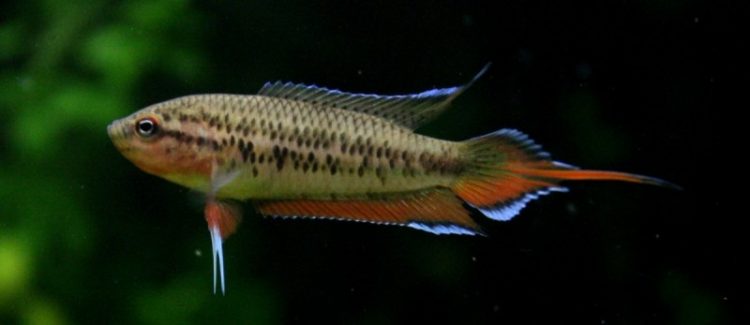
The Pseudosphromenus dayi is a very interesting fish that comes from Southeast Asia. It is stated that the natural habitat of the dayi is the coastal lowlands of the Coromandel coastline in southeast India and the coast region of west Malaya. The body of the dayi is light brown. The fins are a light red with blue on the edges. The fish get to be about 3 inches. The males are supposed to have more pointed and long dorsal, anal, and caudal fins. I do not think that my fish have read the book yet, because I cannot tell them apart unless they are breeding.
Mike Hellweg and I were at Beldts when we found these fish, and of course we both could not leave with purchasing some. When I got my six home, I put them into a 20 long. The tank was kept at 80°F. The fish were fed twice a day, once in the morning and once in the evening. The morning feeds are usually flake food and the evening feeds are either frozen brine shrimp or flake food. The surface of the aquarium is covered with water sprite and java moss and a couple crypts in pots on the bottom of the tank.
I asked Mike how to breed these fish and he told me that they usually spawn in caves. So I then added a couple of caves to the aquarium. I also started feeding live white worms and grindal worms. I also increased the temperature to 82°F. I noticed the females starting to get round bellies. Then one day I noticed a male in one of the caves. When I fed them and he came out to eat I could see his throat had turned bright red. The male did not stay out to eat long. He quickly returned to the cave. If another fish came too close to the cave he would come out to drive the intruder away. I could not stand the wait any longer. I took a flashlight and shined it up into the cave. There I saw the bubble nest the male had built in the top of the cave. I could also see the small white eggs. In about three days I could see the fry falling out of the nest. The male would catch the fry and blow them back into the nest. I then decided to move the fry to another tank. This was easy – all I had to do was place my thumb over the opening of the cave and move it to the new tank. After I moved the cave I quickly caught the male and returned him to the tank with the others. The next day the fry, about 20 of them, were free swimming. I fed the fry live baby brine shrimp. I still lost most of the fry.
This process continued for about three spawnings. I then starting reading up on the dayi again and discovered that the fry are too small to eat baby brine shrimp. I found out that they need green water to survive. I had a 5 gal tank that had turned green on me so the next time I got a spawn I moved the fry to the green water tank. After two or three days the fry were still doing fine. Then after a week I noticed that I did not have as many fry. After looking closer at the tank I discovered that I had a nice collection of hydra in the tank. The only problem with hydra is they feed on fry. I treated the tank to remove the hydra, but it was too late. I had once again lost most of the fry.
By now I was getting discouraged about ever raising any quantity of fry. But, on my 5th spawning I would have better luck. After the fry had hatched out I moved them to a 5 gal tank with a good covering of water sprite. I also started out feeding APR, Artificial Powered Rotifers. You just mix a small portion with water and feed it to your fry. You have to be careful not to overfeed or you will pollute the tank and kill the fry. I did put some snails in the tank to help clean up the excess APR. After about two weeks on APR I started feeding live brine shrimp. This was the most successful method for me; I was able to raise about 20 fry.
After I had tried all these different ways to raise dayi fry, I discovered that I had about 5 or 6 baby dayi in the aquarium with the breeders. Just goes to show you that you never know what is going to happen when you raise fish. So if you are looking for an interesting fish to try to breed they I would suggest Pseudosphromenus dayi.
Leave a Reply